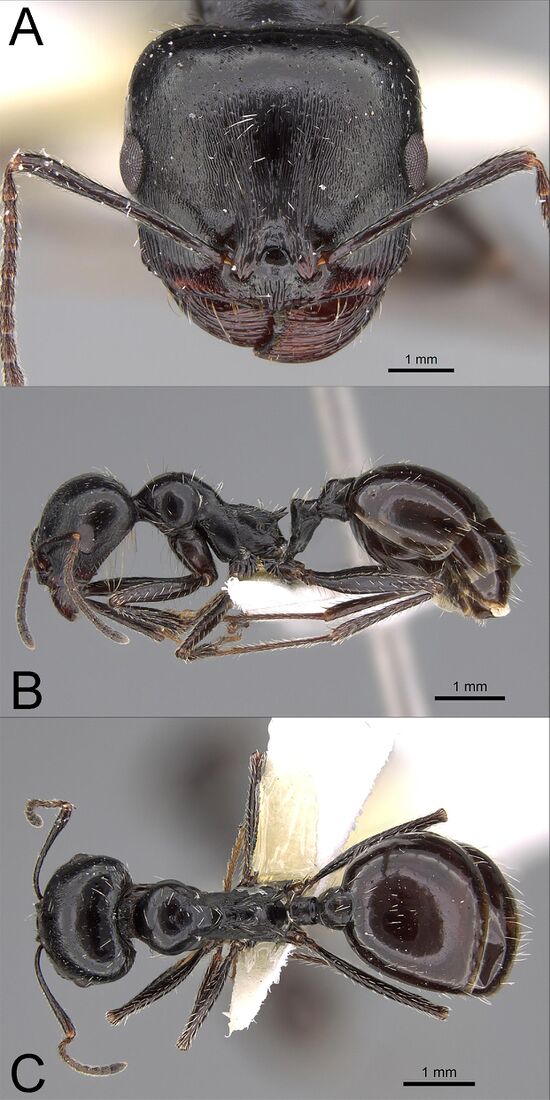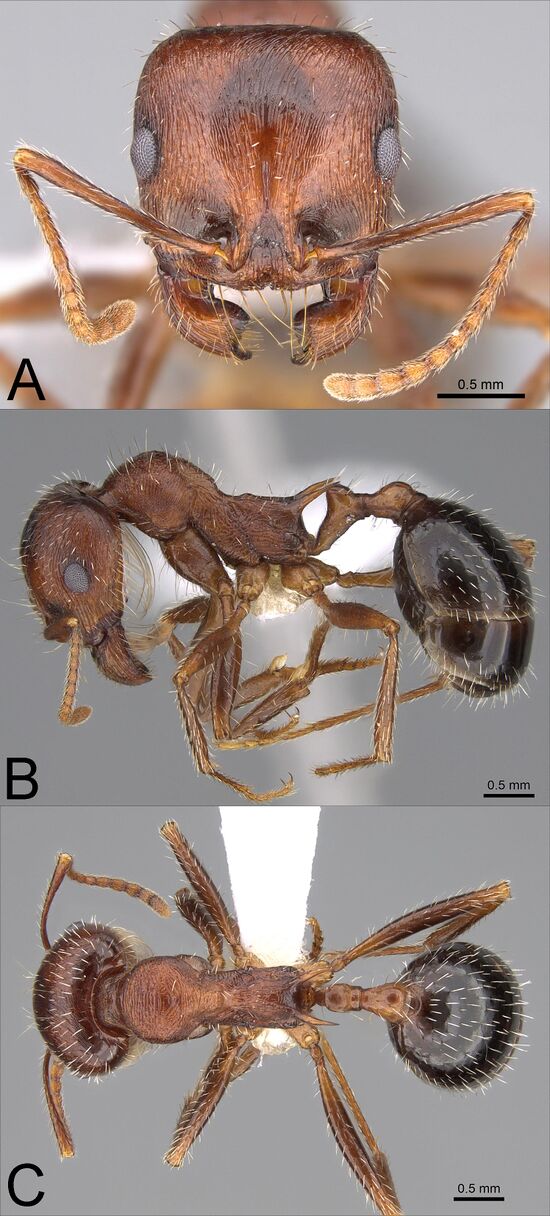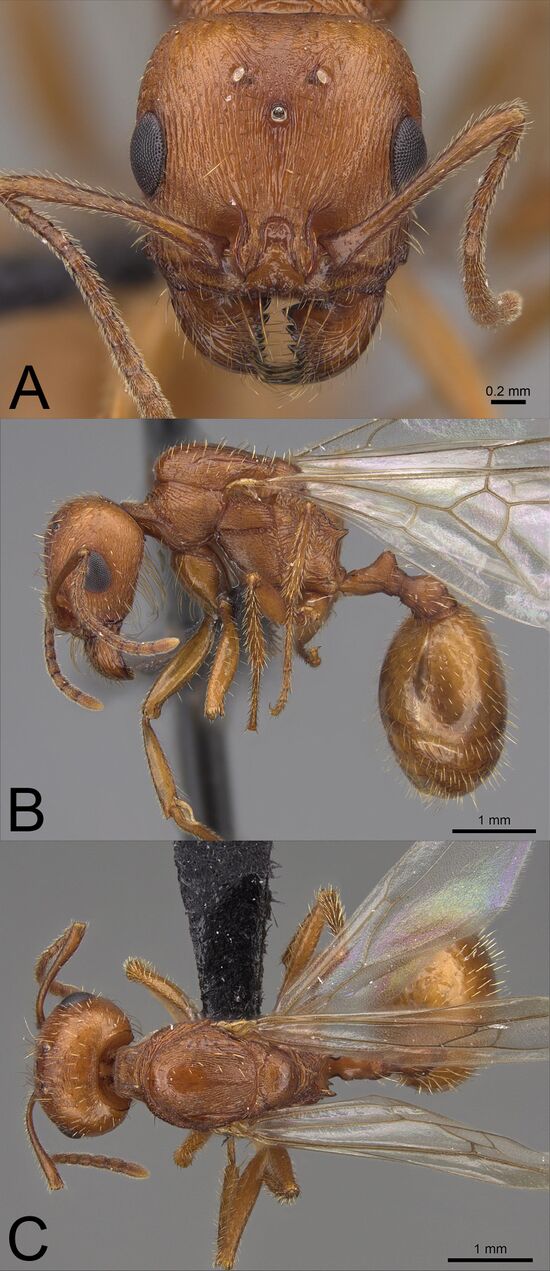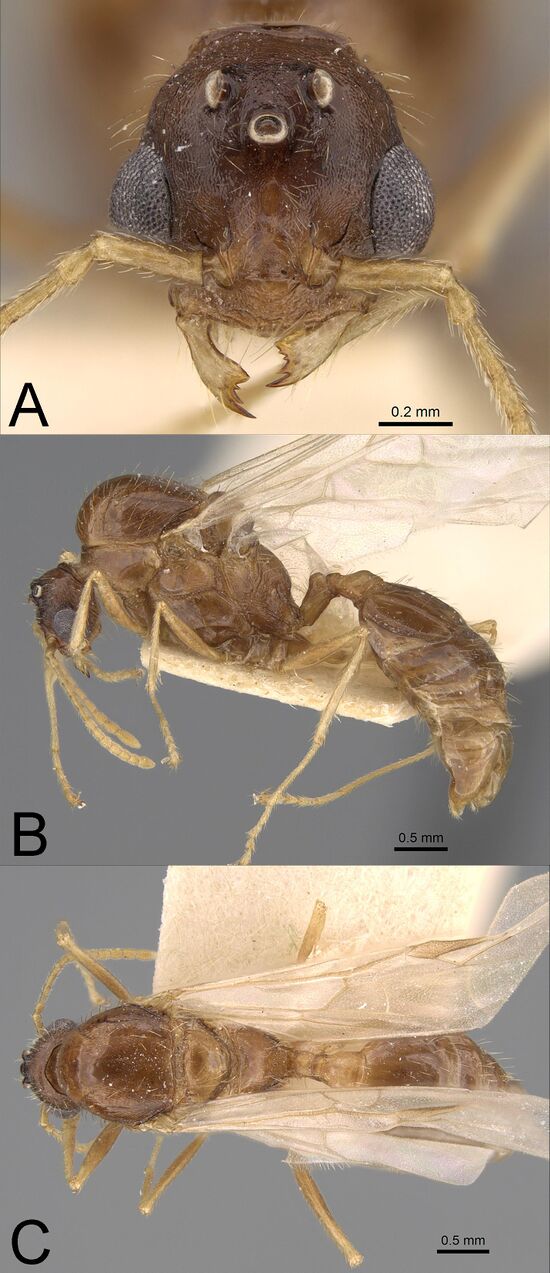Key to Veromessor species
Keys to species of Veromessor based on Johnson et al. (2022, 2023).
See below for keys to queens and males.
Workers
1
- Psammophore well developed, consisting of numerous, long, J-shaped hairs arranged in a distinct row along lateroventral margin of head (Figure 6C-E) => 2
- Psammophore poorly developed, consisting of numerous, short to medium length hairs scattered across ventral surface of head; long J-shaped hairs lacking, or if present J-shaped hairs arranged in a V-shaped row not reaching posterior part of the lateroventral margin of head capsule, usually mixed with straight or evenly curved hairs (Figures 6A–B) => 8
2
return to couplet #1
- Anteromedial margin of clypeus with a small, blunt tooth or projection; in profile, eye narrowed below with a distinct ventral angle; body dark brownish-black to black => Veromessor pergandei
- Anteromedial margin of clypeus entire or concave, but lacking a small medial tooth or projection; in profile, eye rounded below; body usually concolorous yellowish or orangish-brown to rust colored, but never dark brownish-black to black => 3
3
return to couplet #2
- Propodeal spines short, length < 0.5× maximum diameter of the eye (MOD) => 4
- Propodeal spines long, length > 1.0× MOD => 6
4
return to couplet #3
- Larger (HW = 1.33–1.61 mm); maximum basal width of scape greater than maximum preapical width; body concolorous dark yellowish-orange or orangish-brown to rust colored; mandible with 8 teeth, rarely 9 => Veromessor smithi
- Smaller (HW = 0.93–1.37 mm); maximum basal width of scape less than maximum preapical width; body light yellowish to yellowish-orange or yellowish-red, gaster often slightly darker; mandibles with 7 teeth => 5
5
return to couplet #4
- Anteroventral margin of postpetiole interrupted by a transverse ridge, in profile appearing as a minute process, margin weakly concave anterior to process; in dorsal view, pronotum with weak, discontinuous to continuous, wavy to irregular transverse rugae; dorsum of mesonotum with one to few weak, wavy to irregular, usually discontinuous longitudinal rugae => Veromessor pseudolariversi
- Anteroventral margin of postpetiole continuous, in profile lacking a minute process; in dorsal view, pronotum and mesonotum arugose, weakly to strongly coriarious to punctulate-granulate => Veromessor lariversi
6
return to couplet #3
- Base of scape weakly widened; maximum basal width of scape less than maximum preapical width; cephalic dorsum with fine, closely spaced, regular to weakly wavy, longitudinal rugae, interrugae moderately to strongly shining; metasternal process about twice as long as high, apex nearly flat => Veromessor julianus
- Base of scape distinctly widened; maximum basal width of scape greater than maximum preapical width; cephalic dorsum with prominent widely spaced, mostly regular longitudinal rugae, interrugae shining or if rugae closely spaced, then rugae strongly irregular to nearly rugoreticulate, interrugae strongly granulate, dull; metasternal process as long as to slightly longer than high, apex bluntly rounded => 7
7
return to couplet #6
- Propodeal spines longer, length about 2.0× the distance between their bases; cephalic dorsum with prominent, widely spaced, mostly regular longitudinal rugae, interrugae shining; sides of pronotum with wavy to regular rugae, interrugae smooth and strongly shining; posterior margin of frontal lobes notably constricted; in frontal view, base of scape asymmetrical with ventral portion of anterior edge greatly expanded compared to dorsal edge (Figure 12A) => Veromessor chamberlini
- Propodeal spines shorter, length only slightly greater than to rarely 1.5× the distance between their bases; cephalic dorsum with closely spaced, strongly irregular rugae to nearly rugoreticulate, interrugae strongly granulate, dull; sides of pronotum with weakly to strongly irregular rugae to weakly rugoreticulate, interrugae moderately to strongly granulate, dull to weakly shining; posterior margin of frontal lobes not constricted; in frontal view, base of scape mostly symmetrical with ventral and dorsal portions of anterior edge similar in size or with dorsal edge expanded more than ventral edge (Figure 12B) => Veromessor lobognathus
 Johnson et al., 2022, Fig. 12. Photographs of dorsal surface of scape: (A) Veromessor chamberlini (LACMENT359743)—anterior edge of scape curving inward distad of base (red arrow), posterior edge of scape flat to weakly convex at base (black arrow), narrowing distad of base; widened area at base of scape much longer than width at base, and (B) V. lobognathus (LACMENT363932)—anterior edge of scape flat at base (red arrow), posterior edge of scape narrowing from base (black arrow); widened area at base of scape shorter than width at base. Photographs by Michele Esposito from www.AntWeb.org.
Johnson et al., 2022, Fig. 12. Photographs of dorsal surface of scape: (A) Veromessor chamberlini (LACMENT359743)—anterior edge of scape curving inward distad of base (red arrow), posterior edge of scape flat to weakly convex at base (black arrow), narrowing distad of base; widened area at base of scape much longer than width at base, and (B) V. lobognathus (LACMENT363932)—anterior edge of scape flat at base (red arrow), posterior edge of scape narrowing from base (black arrow); widened area at base of scape shorter than width at base. Photographs by Michele Esposito from www.AntWeb.org.
8
return to couplet #1
- Propodeal spines long, in dorsal view, length > 2.5× as long as distance between their bases and > 2.5× MOD; hairs on scape variable in length, suberect to erect, longest hairs about 0.3–0.4× MOD; anterodorsal margin of pronotum with one to several coarse, irregular, transverse rugae; workers mostly monomorphic => Veromessor andrei
- Propodeal spines short, in dorsal view, length less than to about as long as distance between their bases and less than to about as long as MOD; hairs on scape mostly uniform in length, subdecumbent to suberect, longest hairs about 0.1–0.2× MOD; anterodorsal margin of pronotum with weak, wavy to regular longitudinal or oblique rugae, rugae rarely transverse; workers polymorphic => 9
9
return to couplet #8
- In dorsal view, rugae on mesonotum similar to those on pronotum, interrugae weakly dull to shining; antennal scape narrowest near midlength => Veromessor chicoensis
- In dorsal view, rugae on mesonotum distinctly weaker than those on pronotum, interrugae shining; antennal scape narrowest immediately distad of basal bend => Veromessor stoddardi
Queens
1
- Psammophore well developed, consisting of numerous, long, J-shaped hairs arranged in a distinct row along lateroventral margin of head => 2
- Psammophore poorly developed, consisting of numerous, short to medium length hairs scattered across ventral surface of head; long J-shaped hairs sparse or lacking => 8
2
return to couplet #1
- Anteromedial margin of clypeus with a small, blunt tooth or projection; in posterodorsal view, medial and posteromedial surface of petiolar node usually weakly to moderately depressed or concave; concolorous blackish to black; propodeal spines short and triangular, length much less than width at base and length less than distance between their bases => Veromessor pergandei
- Anterior margin of clypeus entire, lacking a small medial tooth or projection; in posterodorsal view, medial and posteromedial portion of petiolar node usually evenly rounded; concolorous orangish or orangish-brown to reddish-brown or bicolored with head and mesosoma orange and gaster blackish or if concolorous dark brownish-black, then propodeal spines elongate, length greater than width at base and length similar to distance between their bases => 3
3
return to couplet #2
- Maximum basal width of scape greater than maximum preapical width => 4
- Maximum basal width of scape less than to similar to maximum preapical width => 6
4
return to couplet #3
- Rugae on cephalic dorsum becoming faint to disappearing above level of ocelli, lacking on posterior margin; in profile, rugae absent posterior to eyes => Veromessor smithi
- Rugae on cephalic dorsum continuing to posterior margin; in profile, rugae present posterior to eyes => 5
5
return to couplet #4
- Posterior margin of frontal lobes notably constricted; in frontal view, base of scape asymmetrical with ventral portion of anterior edge greatly expanded compared to dorsal edge => Veromessor chamberlini
- Posterior margin of frontal lobes not notably constricted; in frontal view, base of scape mostly symmetrical with ventral and dorsal portions of anterior edge similar in size or with dorsal edge expanded more than ventral edge => Veromessor lobognathus
6
return to couplet #3
- Rugae on cephalic dorsum continue onto posterior margin; propodeal spines elongate, length greater than width at base and length similar to distance between their bases; restricted to the Baja California peninsula of Mexico => Veromessor julianus
- Rugae on cephalic dorsum fade and disappear posterad, posterior margins smooth and shining; propodeal spines triangular, length less than width at base and length much less than distance between their bases; only known from California and Nevada => 7
7
return to couplet #6
- In profile, anteroventral margin of postpetiole interrupted by a minute process, margin weakly concave anterior to process; smaller (HW = 1.21–1.36 mm; ML = 1.95–2.04 mm); longitudinal rugae present over most to all of katepisternum => Veromessor pseudolariversi
- In profile, anteroventral margin of postpetiole continuous, lacking a minute process; larger (HW = 1.53–1.62 mm; ML = 2.78–2.98 mm); longitudinal rugae present on anterior and posterior portion of katepisternum, central portion lacking rugae => Veromessor lariversi
8
return to couplet #1
- Dorsal base of scape with a well developed, horizontal flange; mesoscutellum with numerous longitudinal rugae; medial lobe of clypeus with several coarse longitudinal rugae; hairs on scape variable in length, longest hairs suberect to erect => Veromessor andrei
- Dorsal base of scape may be broadened but lacking a horizontal flange; mesoscutellum arugose, smooth and shining; medial lobe of clypeus smooth and shining, lacking rugae, or rugae occasionally near anterior margin; hairs on scape similar in length, all hairs decumbent => 9
9
return to couplet #8
- Smaller (HW 1.39–1.58 mm; ML = 2.10–2.26 mm); katepisternum with longitudinal rugae; hairs on first gastral tergum longer, length of longest hairs approaching to equaling MOD; rugae on cephalic dorsum continue onto posterior margin => Veromessor chicoensis
- Larger (HW = 1.61–1.75 mm; ML = 2.77–2.97 mm); katepisternum mostly smooth and shining; hairs on first gastral tergum shorter, length of longest hairs < 0.4–0.5× MOD; rugae on cephalic dorsum fade to disappear on posterior margin => Veromessor stoddardi
Males
1
- Dorsum of mesoscutum smooth and shining, rugae and/or striae lacking => 2
- Rugae and/or striae cover some to most of dorsum of mesoscutum => 3
2
return to couplet #1
- Mandibles with 2–3 teeth basad of preapical tooth; in profile; metasternal process triangular, acuminate (Figure 1E) => Veromessor lariversi
- Mandibles with 1–2 minute denticles or teeth basad of preapical tooth; metasternal process elongate, slender, with a withered look (Figure 1I) => Veromessor smithi
3
return to couplet #1
- Psammophore consists of numerous, long, J-shaped hairs along lateroventral margin of head and larger (HW = 1.23–1.46 mm; PPW = 0.98–1.29 mm; EL = 0.50–0.59) => Veromessor pergandei
- Psammophore consists of numerous hairs scattered across ventral surface of head and/or smaller (HW = 0.68–1.00 mm; PPW = 0.37–0.70 mm; EL = 0.33–0.41 mm) => 4
4
return to couplet #3
- Occurring east of the Sierra Nevada and north of San Gabriel Mountains of California and east into Nevada, Arizona, and further east => 5
- Occurring in southwestern Oregon, California west of the Sierra Nevada, southwestern California, and the Baja California peninsula, Mexico => 6
5
return to couplet #4
- Body blackish to black; in profile, anteroventral margin of postpetiole interrupted by small transverse ridge that appears as a minute process; anepisternum and katepisternum rugose => Veromessor pseudolariversi
- Body light brown to brown; in profile, anteroventral margin of postpetiole continuous, lacking a minute process; anepisternum and katepisternum mostly smooth and shining to coriarious => Veromessor lobognathus
6
return to couplet #4
- In profile, propodeum evenly rounded, lacking tubercles, denticles, or enlarged rugae => 7
- In profile, propodeum not evenly rounded, profile interrupted by denticles, tubercles, or enlarged rugae => 8
7
return to couplet #6
- Restricted to the Baja California peninsula of Mexico => Veromessor julianus
- Restricted to California south and west of San Gabriel Mountains => Veromessor chamberlini
8
return to couplet #6
- Anepisternum rugose => Veromessor andrei
- Anepisternum contiguously punctate-granulate to mostly smooth to roughened or with faint rugae => 9
9
return to couplet #8
- Anepisternum and katepisternum contiguously punctulate-granulate, anepisternum occasionally with scattered rugae; sides of propodeum contiguously punctulate-granulate with scattered, weak longitudinal rugae; in profile, area posterior to eyes and posterior corners strongly punctulate-granulate with several weak longitudinal rugae => Veromessor chicoensis
- Anepisternum mostly smooth to roughened or with faint rugae; katepisternum roughened or coriarious; in profile, area posterior to eyes and posterior corners with prominent longitudinal rugae, interrugae moderately punctulate-granulate => Veromessor stoddardi
References
- Johnson, R.A., Borowiec, M.L., Snelling, R.R., Cole, A.C. 2022. A taxonomic revision and a review of the biology of the North American seed-harvester ant genus Veromessor (Hymenoptera: Formicidae: Myrmicinae). Zootaxa 52061, 1-115 (doi:10.11646/zootaxa.5206.1.1).
- Johnson, R.A., Borowiec, M.L., Snelling, R.R., Cole, A.C. 2023. Erratum: A taxonomic revision and a review of the biology of the North American seed-harvester ant genus Veromessor (Hymenoptera: Formicidae: Myrmicinae) Zootaxa 5206 1: 1–115. Zootaxa 5270(3), 599 (doi:10.11646/zootaxa.5270.3.11).









































